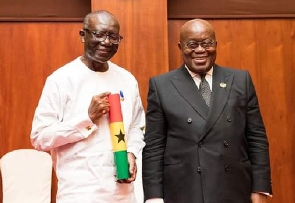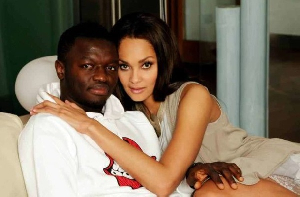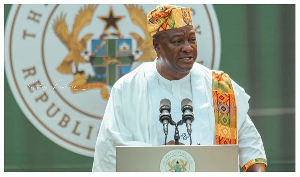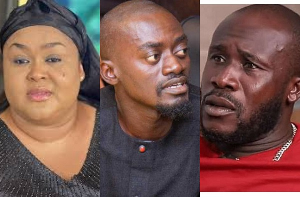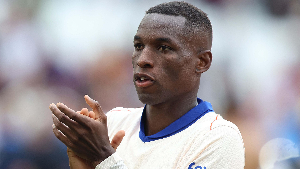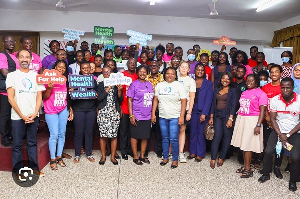The government of Ghana is essentially bankrupt, and has turned to the International Monetary Fund for its 17th financial rescue since 1957.
Emmanuel Cherry, the chief executive of an association of Ghanaian construction companies, sat in a cafe at the edge of Accra Children’s Park, near the derelict Ferris wheel and kiddie train, as he tallied up how much money government entities owe thousands of contractors.
Before interest, he said, the back payments add up to 15 billion cedis, roughly $1.3 billion. “Most of the contractors are home,” Mr. Cherry said. Their workers have been laid off.
Like many others in this West African country, the contractors have to wait in line for their money. Teacher trainees complain they are owed two months of back pay. Independent power producers that have warned of major blackouts are owed $1.58 billion.
The government is essentially bankrupt. After defaulting on billions of dollars owed to foreign lenders in December, the administration of President Nana Akufo-Addo had no choice but to agree to a $3 billion loan from the lender of last resort, the International Monetary Fund.
It was the 17th time Ghana has been compelled to turn to the fund since it gained independence in 1957.
This latest crisis was partly prompted by the havoc of the coronavirus pandemic, Russia’s invasion of Ukraine, and higher food and fuel prices. But the tortuous cycle of crisis and bailout has plagued dozens of poor and middle-income countries throughout Africa, Latin America and Asia for decades.
These pitiless loops will be discussed at the latest United Nations General Assembly, which begins on Tuesday. The debt load for developing countries — now estimated to top $200 billion — threatens to upend economies and unravel painstaking gains in education, health care and incomes. But poor and low-income countries have struggled to gain sustained international attention.
In Ghana, the I.M.F. laid out a detailed rescue plan to get the country back on its feet — reining in debt and spending, raising revenue and protecting the poorest — as Accra negotiates with foreign creditors.
Still, a nagging question for Ghana and other emerging nations in debt persists: Why will this time be any different?
The latest rescue plan outlined for Ghana addresses key problems, said Tsidi M. Tsikata, a senior fellow at the African Center for Economic Transformation in Accra. But so did many of the previous ones, he said, and still crises recurred.
The last time Ghana turned to the fund was in 2015. Within three years, the country was on its way to paying back the loan, and was among the world’s fastest-growing economies. Ghana was held up as a model for the rest of Africa.
Agricultural production was up, and major exports — cocoa, oil and gold — were rising. The country had invested in infrastructure and education, and had begun a cleanup of the banking industry, which was riddled with distressed lenders.
Yet Accra is again desperately in need. The I.M.F. loan agreement, and the delivery of a $600 million installment in May, have helped stabilize the economy, settle wild fluctuations in currency levels and restore a modicum of confidence. Inflation is still running above 40 percent but is down from its peak of 54 percent in January.
Despite the I.M.F.’s blueprint, though, Mr. Tsikata, previously a division chief at the fund for three decades, said the chance that Ghana wouldn’t be in a similar position a few years down the road “rests on a wing and a prayer.”
The effects of devastating climate change loom over the problem. Within the next decade, a United Nations analysis estimates, trillions of dollars in new financing will be needed to mitigate the impact on developing countries.
In Ghana, the government owed $63.3 billion at the end of 2022 not just to foreign creditors but also to homegrown lenders — pension funds, insurance companies and local banks that believed the government was a safe investment. The situation was so unusual that the I.M.F. for the first time made settling this domestic debt a prerequisite for a bailout. A partial restructuring, which cut returns and extended the due dates, was completed in February. While the haircut may have been necessary, it undermined confidence in the banks.
As for foreign lenders, there are thousands of private, semipublic and governmental creditors, including China, which have different objectives, loan arrangements and regulatory controls.
The magnitude and type of debt means “this crisis is much deeper than the type of economic difficulties Ghana has faced in the past,” said Stéphane Roudet, the I.M.F.’s mission chief to Ghana.
The dizzying proliferation of lenders now characterizes much of the debt burdening distressed countries around the globe — making it also more complex and difficult to resolve.
“You don’t have six people in a room,” said Joseph E. Stiglitz, a Nobel Prize winner and a former chief economist at the World Bank. “You have a thousand people in a room.”
‘Last Year Was the Worst of All.’
Outside Victoria Chrappah’s narrow stall in Makola Market, snaking lines of sellers hawked live chickens, toilet paper packs and electronic chargers from giant baskets balanced on their heads.
As restructuring negotiations with foreign lenders continue, households and businesses are doing their best to cope. Ms. Chrappah has been selling imported bathmats, shower curtains and housewares for more than 20 years.
“Last year was the worst of all,” she said.
Inflation surged, and the cedi lost more than half its value compared with the U.S. dollar — a blow to consumers and businesses when a country imports everything from medicine to cars. The Bank of Ghana jacked up interest rates to cope with inflation, hurting businesses and households that rely on short-term borrowing or want to invest. The benchmark rate is now 30 percent.
Because of the rapidly depreciating currency, Ms. Chrappah explained, “you can sell in the morning at one price, and then you have to think of changing the price the following day.”
Purchasing power as well as the value of savings has been halved. Doreen Adjetey, product manager for Dalex Swift, a finance company based in Accra, said a bottle of Tylenol to soothe her 19-month-old baby’s teething pain cost 50 cedis last year. Now it’s 110.
A month’s worth of groceries cost more than 3,000 cedis compared with 1,000. Before, she and her husband had a comfortable monthly income of 10,000 cedis, worth about $2,000 when the exchange rate was 5 cedis to the dollar. At today’s rate, it’s worth $889.
Joe Jackson, the director of business operations at Dalex, said default rates for small and medium-size enterprises “are through the roof,” jumping to 70 percent from 30 percent.
The real estate and construction market has also tanked. “There’s been a drastic drop in the number of homes in the first-buyer segment of the market,” said Joseph Aidoo Jr., executive director of Devtraco Limited, a large real estate developer.
When the pandemic struck in 2020, paralyzing economies, shrinking revenues and raising health care costs, fear of a global debt crisis mounted. Ghana, like many developing countries, had borrowed heavily, encouraged by years of low commercial rates.
As the Federal Reserve and other central banks raised interest rates to combat inflation, developing countries’ external debt payments — priced in dollars or euros — unexpectedly ballooned at the same time that prices of imported food, fuel and fertilizer shot up.
As Ghana’s foreign reserves skidded toward zero, the government began paying for refined oil imports directly with gold bought by the central bank.
Even so, while the series of unfortunate global events may have supercharged Ghana’s debt crisis, they didn’t create it.
The current government, like previous ones, spent much more than it collected in revenues. Taxes as a share of total output are also lower than the average across the rest of Africa.
To make up the shortfall, the government kept borrowing, offering higher and higher interest rates to attract foreign lenders. And then it borrowed more to pay back the interest on previous loans. By the end of last year, interest payments on debt were gobbling up more than 70 percent of government revenues.
“The government is bloated and inefficient,” said E. Gyimah-Boadi, the board chair of Afrobarometer, a research network. Half-completed schools, hospitals and other projects are abandoned when a new administration comes in. Corruption and mismanagement are also problems, several economists and business leaders in Ghana said.
More fundamentally, Ghana’s economy is not set up to generate the kind of jobs and incomes needed for broad development and sustainable growth.
“Ghana’s success story is real,” said Aurelien Kruse, the lead country economist in the Accra office of the World Bank. “Where it may have been a bit oversold,” though, is that “the fast growth has not been diversified.” The economy is primarily dependent on exports of raw materials like cocoa, oil and gold, which peak and swoop in price.
Manufacturing accounts for a mere 10 percent of the country’s output — a decline from 2013. Without a thriving industrial sector to provide steady employment and produce exportable goods, Ghana has no other streams of revenue from abroad, which can build wealth and pay for needed imports.
This model — the import of expensive goods and the export of cheap resources — characterized the colonial system.
Senyo Hosi, executive chairman of Kleeve & Tove, an investment company based in Accra, said he had an agribusiness that produced rice in the Volta region and worked with more than 1,000 growers. He can’t do required upgrades to equipment, though, because 30 percent interest rates make borrowing impossible. “I stopped production,” he said.
‘For Us It Means Shutdown.’
As the global financial system struggles to restructure hundreds of billions of dollars in existing debt, the question of how to avoid the debt trap in the first place remains more urgent than ever.
Large chunks of money are required to invest in desperately needed roads, technology, schools, clean energy and more. But dozens of countries lack the domestic savings needed to pay for them, and grants and low-cost loans from international institutions are scarce.
“The fundamental issue is the need for financing,” said Brahima S. Coulibaly, a senior fellow at the Brookings Institution.
So governments turn to international capital markets, where investors are foraging the world for high returns. Both political leaders and investors often look for short-term wins, whether in the next election or earnings call, said Martin Guzman, a former finance minister of Argentina who handled his country’s debt restructuring in 2020.
This free flow of capital around the globe has resulted in a flood of financial crises. “Inequality is embedded in the international financial architecture,” a United Nations Global Crisis Response Group concluded in an analysis.
Even worthy investments — and not all of them are — don’t always generate enough revenue to repay the loans.
When bad times hit or foreign lenders get spooked, governments are left in the lurch. This process can be accelerated in Africa, where research has found there is an exaggerated perception of risk, which lowers credit ratings and raises financing costs.
Without a safety cushion to fall back on, a small government cash crunch can turn into a disaster. Think of a household in a tough stretch that can’t cover next month’s rent and is evicted. Now instead of being a few hundred dollars in debt, the members of the household are homeless.
“For us,” said Ken Ofori-Atta, Ghana’s finance minister, a credit downgrade “means shutdown.”
Several organizations have sketched out escape routes from the debt trap, including more low-cost lending from multilateral banks like the World Bank.
Debt Justice, which advocates for debt forgiveness, along with many economists, argues that some of the $200 billion in debt must be erased. It has also called for governments and lenders to publicly reveal the amount and terms of loans, and what the money was used for so it can be better tracked and audited.
Other research groups have looked at ways to stabilize the evolving African bond market and help governments survive short-term shortfalls as well as boom-and-bust swings in commodity prices.
Mr. Ofori-Atta said he had “extreme confidence” that Ghana would have strong growth after it emerged from this debt tunnel.
But the problem of finding manageable amounts of low-cost investment capital remains.
Where does an African country — or any developing country — get the type of financing it needs to grow? Mr. Ofori-Atta asked.
Before the cycle of debt crises is broken, that question will have to be answered.
General News of Wednesday, 20 September 2023
Source: nytimes.com





